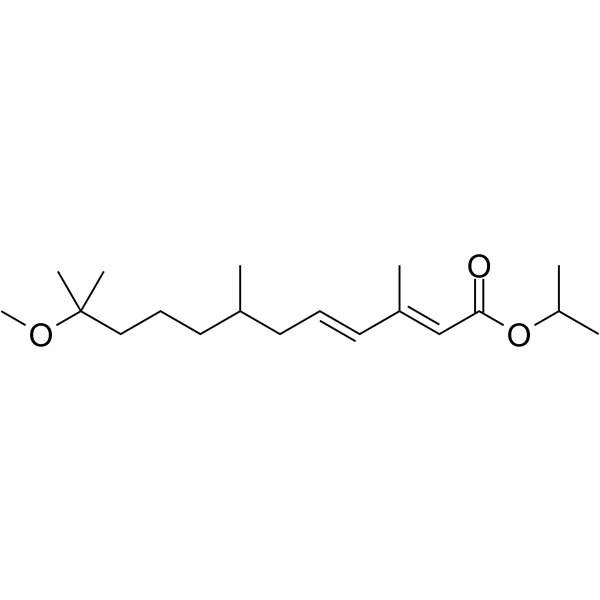
Methoprene
CAS No. 40596-69-8
Methoprene( ZR-515 )
Catalog No. M26753 CAS No. 40596-69-8
Methoprene is a juvenile hormone (JH) mimic and a biological pesticide.
Purity : >98% (HPLC)
 COA
COA
 Datasheet
Datasheet
 HNMR
HNMR
 HPLC
HPLC
 MSDS
MSDS
 Handing Instructions
Handing Instructions
| Size | Price / USD | Stock | Quantity |
| 25MG | 50 | Get Quote |


|
| 50MG | 71 | Get Quote |


|
| 100MG | 87 | Get Quote |


|
| 200MG | Get Quote | Get Quote |


|
| 500MG | Get Quote | Get Quote |


|
| 1G | Get Quote | Get Quote |


|
Biological Information
-
Product NameMethoprene
-
NoteResearch use only, not for human use.
-
Brief DescriptionMethoprene is a juvenile hormone (JH) mimic and a biological pesticide.
-
DescriptionMethoprene is a juvenile hormone (JH) mimic and a biological pesticide. Methoprene acts as an insect growth regulator interfering with the lifecycles of insects and preventing insects from reaching maturity or reproducing.(In Vivo):The time of first brood deposition is affected by methoprene, with a clear concentration-dependent response and a NOEC of 32 nM. Methoprene reduces fecundity according to a 2-segmented line, with thresholds of 24 and < or =0.18 nM. Methoprene reduces the growth rate of daphnids with evidence of only a single concentration-response line, having a threshold of 12.6 nM. Molt frequency is reduced by methoprene in a concentration-dependent manner, with a response curve corresponding to a 2-segmented line and thresholds at 4.2 and 0.21 nM.
-
In VitroMethoprene reduces the growth rate of daphnids with evidence of only a single concentration-response line, having a threshold of 12.6 nM. Molt frequency is reduced by methoprene in a concentration-dependent manner, with a response curve corresponding to a 2-segmented line and thresholds at 4.2 and 0.21 nM. An endpoint related to reproductive maturation, the time of first brood deposition, is also affected by methoprene, with a clear concentration-dependent response and a NOEC of 32 nM. Methoprene reduces fecundity according to a 2-segmented line, with thresholds of 24 and < or =0.18 nM. Methoprene elicits significant toxicity to endocrine-related processes in the 5-50 nM concentration range.
-
In Vivo——
-
SynonymsZR-515
-
PathwayOthers
-
TargetOther Targets
-
RecptorE3 Ligase Ligand-Linker Conjugate
-
Research Area——
-
Indication——
Chemical Information
-
CAS Number40596-69-8
-
Formula Weight310.478
-
Molecular FormulaC19H34O3
-
Purity>98% (HPLC)
-
SolubilityIn Vitro:?Ethanol : 100 mg/mL (322.09 m)
-
SMILESCOC(C)(C)CCCC(C)C\C=C\C(\C)=C\C(=O)OC(C)C
-
Chemical Name——
Shipping & Storage Information
-
Storage(-20℃)
-
ShippingWith Ice Pack
-
Stability≥ 2 years
Reference
1.An S, et al. Small-molecule PROTACs: An emerging and promising approach for the development of targeted therapy drugs. EBioMedicine. 2018 Oct;36:553-562
molnova catalog



related products
-
Dulozafone
Dulozafone (F1933) has an anti- showed anticonvulsant activity in a brain amygdala ignition model and protected fully ignited rats from generalized seizures.
-
Spiramycin
A macrolide antibiotic produced by Streptomyces ambofaciens.
-
Valerenic acid
Valerenic acid is a natural product.



 Cart
Cart
 sales@molnova.com
sales@molnova.com


